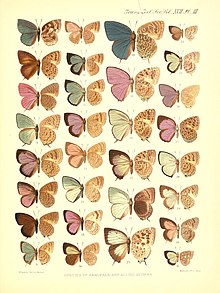| Arhopala anamuta | |
|---|---|

| |
| Arhopala anamuta in Bethune Baker (figure 6 male) | |
|
Scientific classification
| |
| Domain: | Eukaryota |
| Kingdom: | Animalia |
| Phylum: | Arthropoda |
| Class: | Insecta |
| Order: | Lepidoptera |
| Family: | Lycaenidae |
| Genus: | Arhopala |
| Species: | A. anamuta
|
| Binomial name | |
| Arhopala anamuta | |
Arhopala anamuta is a butterfly in the family Lycaenidae. It was described by Georg Semper in 1890. It is found in the Indomalayan realm where it is endemic to the Philippines. [2]
Description
Only the male known [1927] , having been taken near Davao in Mindanao; distinguished by the whole brown upper surface showing a violet reflection only when seen in a certain direction.The bands beneath are distinctly composed of oval spots. From allata. which it entirely resembles beneath, it is separated by quite tailless wings. [3]
References
- ^ Semper, G.1886-1892. Die Schmetterlinge der Philippinischen Inseln, Beitrag zur Indo-Malayischen Lepidopteren-Fauna. (Die Tagfalter). l: 380 pp, 49 pls. In C. G. Semper, Reisen im Archipen der Philippinen, (2)5. Weisbaden
- ^ Seitz, A., 1912-1927. Die Indo-Australien Tagfalter Grossschmetterlinge Erde 9
-
^ Seitz , A. Band 9: Abt. 2, Die exotischen Großschmetterlinge, Die indo-australischen Tagfalter, 1927, 1197 Seiten 177 Tafeln
 This article incorporates text from this source, which is in the
public domain.
This article incorporates text from this source, which is in the
public domain.
External links
- Arhopala Boisduval, 1832 at Markku Savela's Lepidoptera and Some Other Life Forms. Retrieved June 3, 2017.
| Arhopala anamuta | |
|---|---|

| |
| Arhopala anamuta in Bethune Baker (figure 6 male) | |
|
Scientific classification
| |
| Domain: | Eukaryota |
| Kingdom: | Animalia |
| Phylum: | Arthropoda |
| Class: | Insecta |
| Order: | Lepidoptera |
| Family: | Lycaenidae |
| Genus: | Arhopala |
| Species: | A. anamuta
|
| Binomial name | |
| Arhopala anamuta | |
Arhopala anamuta is a butterfly in the family Lycaenidae. It was described by Georg Semper in 1890. It is found in the Indomalayan realm where it is endemic to the Philippines. [2]
Description
Only the male known [1927] , having been taken near Davao in Mindanao; distinguished by the whole brown upper surface showing a violet reflection only when seen in a certain direction.The bands beneath are distinctly composed of oval spots. From allata. which it entirely resembles beneath, it is separated by quite tailless wings. [3]
References
- ^ Semper, G.1886-1892. Die Schmetterlinge der Philippinischen Inseln, Beitrag zur Indo-Malayischen Lepidopteren-Fauna. (Die Tagfalter). l: 380 pp, 49 pls. In C. G. Semper, Reisen im Archipen der Philippinen, (2)5. Weisbaden
- ^ Seitz, A., 1912-1927. Die Indo-Australien Tagfalter Grossschmetterlinge Erde 9
-
^ Seitz , A. Band 9: Abt. 2, Die exotischen Großschmetterlinge, Die indo-australischen Tagfalter, 1927, 1197 Seiten 177 Tafeln
 This article incorporates text from this source, which is in the
public domain.
This article incorporates text from this source, which is in the
public domain.
External links
- Arhopala Boisduval, 1832 at Markku Savela's Lepidoptera and Some Other Life Forms. Retrieved June 3, 2017.